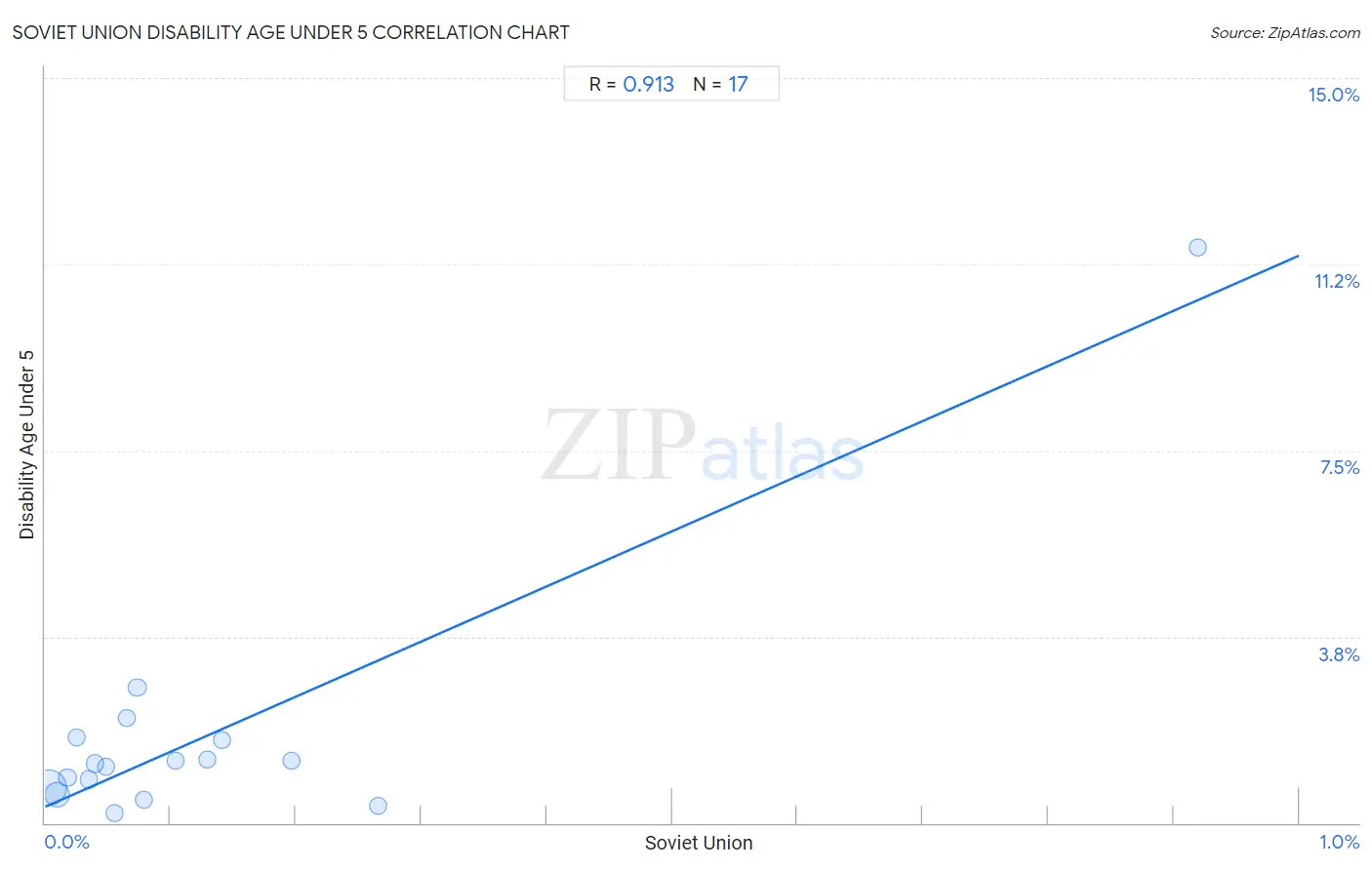Soviet Union Disability Age Under 5
COMPARE
Soviet Union
Select to Compare
Disability Age Under 5
Soviet Union Disability Age Under 5
0.95%
DISABILITY | AGE UNDER 5
100.0/ 100
METRIC RATING
13th/ 347
METRIC RANK
Soviet Union Disability Age Under 5 Correlation Chart
The statistical analysis conducted on geographies consisting of 37,806,626 people shows a near-perfect positive correlation between the proportion of Soviet Union and percentage of population with a disability under the age of 5 in the United States with a correlation coefficient (R) of 0.913 and weighted average of 0.95%. On average, for every 1% (one percent) increase in Soviet Union within a typical geography, there is an increase of 11.1% in percentage of population with a disability under the age of 5.

It is essential to understand that the correlation between the percentage of Soviet Union and percentage of population with a disability under the age of 5 does not imply a direct cause-and-effect relationship. It remains uncertain whether the presence of Soviet Union influences an upward or downward trend in the level of percentage of population with a disability under the age of 5 within an area, or if Soviet Union simply ended up residing in those areas with higher or lower levels of percentage of population with a disability under the age of 5 due to other factors.
Demographics Similar to Soviet Union by Disability Age Under 5
In terms of disability age under 5, the demographic groups most similar to Soviet Union are Yuman (0.95%, a difference of 0.080%), Immigrants from Hong Kong (0.95%, a difference of 0.11%), Immigrants from Grenada (0.94%, a difference of 0.17%), Afghan (0.94%, a difference of 0.19%), and Marshallese (0.94%, a difference of 0.95%).
| Demographics | Rating | Rank | Disability Age Under 5 |
| Ute | 100.0 /100 | #6 | Exceptional 0.86% |
| Immigrants from Afghanistan | 100.0 /100 | #7 | Exceptional 0.91% |
| Immigrants from Yemen | 100.0 /100 | #8 | Exceptional 0.91% |
| Immigrants from Fiji | 100.0 /100 | #9 | Exceptional 0.92% |
| Marshallese | 100.0 /100 | #10 | Exceptional 0.94% |
| Afghans | 100.0 /100 | #11 | Exceptional 0.94% |
| Immigrants from Grenada | 100.0 /100 | #12 | Exceptional 0.94% |
| Soviet Union | 100.0 /100 | #13 | Exceptional 0.95% |
| Yuman | 100.0 /100 | #14 | Exceptional 0.95% |
| Immigrants from Hong Kong | 100.0 /100 | #15 | Exceptional 0.95% |
| Immigrants from Israel | 100.0 /100 | #16 | Exceptional 0.96% |
| Immigrants from China | 100.0 /100 | #17 | Exceptional 0.96% |
| Immigrants from Barbados | 100.0 /100 | #18 | Exceptional 0.97% |
| Puget Sound Salish | 100.0 /100 | #19 | Exceptional 0.97% |
| Nepalese | 100.0 /100 | #20 | Exceptional 0.97% |
Soviet Union Disability Age Under 5 Correlation Summary
| Measurement | Soviet Union Data | Disability Age Under 5 Data |
| Minimum | 0.0032% | 0.19% |
| Maximum | 0.92% | 11.6% |
| Range | 0.92% | 11.4% |
| Mean | 0.13% | 1.8% |
| Median | 0.065% | 1.2% |
| Interquartile 25% (IQ1) | 0.030% | 0.64% |
| Interquartile 75% (IQ3) | 0.14% | 1.7% |
| Interquartile Range (IQR) | 0.11% | 1.0% |
| Standard Deviation (Sample) | 0.22% | 2.6% |
| Standard Deviation (Population) | 0.21% | 2.5% |
Correlation Details
| Soviet Union Percentile | Sample Size | Disability Age Under 5 |
[ 0.0% - 0.5% ] 0.0032% | 24,301,306 | 0.71% |
[ 0.0% - 0.5% ] 0.0094% | 10,325,563 | 0.58% |
[ 0.0% - 0.5% ] 0.018% | 644,752 | 0.92% |
[ 0.0% - 0.5% ] 0.025% | 459,758 | 1.7% |
[ 0.0% - 0.5% ] 0.035% | 418,419 | 0.87% |
[ 0.0% - 0.5% ] 0.040% | 638,060 | 1.2% |
[ 0.0% - 0.5% ] 0.049% | 332,713 | 1.1% |
[ 0.0% - 0.5% ] 0.055% | 115,741 | 0.19% |
[ 0.0% - 0.5% ] 0.065% | 179,009 | 2.1% |
[ 0.0% - 0.5% ] 0.073% | 83,099 | 2.7% |
[ 0.0% - 0.5% ] 0.079% | 86,036 | 0.48% |
[ 0.0% - 0.5% ] 0.10% | 74,812 | 1.2% |
[ 0.0% - 0.5% ] 0.13% | 26,346 | 1.3% |
[ 0.0% - 0.5% ] 0.14% | 34,048 | 1.7% |
[ 0.0% - 0.5% ] 0.20% | 32,537 | 1.3% |
[ 0.0% - 0.5% ] 0.27% | 52,360 | 0.34% |
[ 0.5% - 1.0% ] 0.92% | 2,067 | 11.6% |